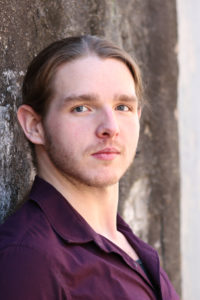On the November 14 edition of Ecstatic Listening (Mondays, 8-10 pm), host and friendly neighborhood radio witch Jess is joined by artist, archivist, singer, and educator Casey Edwards to discuss and premier his piece “Archival Amalgamation I: All Our Holocausts.” Below are links and notes from Casey about pieces that related to, inspired, or otherwise informed his work.
From An Ordinary Evening in New Haven, written/recited by Wallace Stevens
In this recording, Wallace Stevens reads a few of the poems from the larger collection, An Ordinary Evening in New Haven. This is the recording from which I sampled the “and yet” line that repeats in my radio art piece. “X. It is Fatal in the moon” is the poem by this author that Merrill Gillespie set to music to create the art song I pulled form BMCM+AC’s archives.
“The fairies are dancing all over the world” written/read by Michael Rumaker (2008)
This is a reading of a poem by the author in September of 2008 for The Spirit of Black Mountain College, a 75th anniversary celebration that occurred at Lenoir-Rhyne University and the Hickory Museum of Art. A large copy of this poem exists in the Merrill Gillespie Collection at Black Mountain College Museum + Arts Center, and it is printed in a continuous fashion on one page to facilitate uninterrupted reading. Rumaker was a student at the College from 1952-1955 and mentions Gillespie at length in his memoir Black Mountain Days. Having recordings of artists performing or reciting their own works is always a treat because we are able to gain insight into the inspiration behind those works, which can inform our own interpretations.
“Death be not proud” by John Donne, read by Sir John Gielgud
“Death, Be Not Proud” is a famous poem written by metaphysical poet John Donne in 1609. This work has been the inspiration for readings and other artworks since its publication, including a song cycle set of nine set to music by Benjamin Britten in 1945. This reading of it is by John Gielgud, prominent 20th century British actor.
Benjamin Britten set “Death be not proud” as an art song after touring the recently liberated Nazi Bergen-Belsen concentration camp along with nine others as part of a song cycle, The Holy Sonnets of John Donne, Op. 35. This recording is of Benjamin Britten performing it with tenor Peter Pears, his life partner. Britten is widely regarded as a master when it comes to musical text settings, and his art song works are a major part of the classical repertoire. This piece is an example of how John Donne’s texts have been a major inspiration in all art forms, especially those created after the World War II era.
Premiered in 2005 at the San Francisco Opera, Adams’ Doctor Atomic tells the story of the development of the atomic bomb in the Manhattan Project and the tragic implications of how it would be used for war. The character singing this aria, portrayed by Gerald Finley in this recording, is J. Robert Oppenheimer, who was credited as the main developer of the atomic bomb. Another participant in the Manhattan Project was Natasha Goldowski, who taught at Black Mountain College for a period. Merrill Gillespie revered her; he wrote a piano waltz for her, which is in the Merrill Gillespie Collection at BMCM+AC.
The AIDS Quilt Songbook was birthed in the 90s out of the frustration experienced by gay men who were largely disregarded during the AIDS pandemic. Ricky Ian Gordon is well known for his art songs, which blur the line between classical opera and musical theater.
This is another art song from the AIDS Quilt Songbook, composed by active composer Libby Larsen.
When AIDS Was Funny directed and produced by Scott Calonic
This documentary short created by Scott Calonic is a series of Reagan Administration White House briefings recordings during which reporters ask about the situation regarding the growing AIDS pandemic from its beginnings in the 1982 through 1985. You can hear the laughter throughout the recordings as people treat the tragedy as a gigantic joke. Growing up, I recall similar levels of unprofessionalism regarding this topic, such as a middle school health teacher declaring that she thought AIDS was God’s wrath on gay men in Mississippi.
COVID-19 through the lens of my experience with the HIV/AIDS pandemic | Trudy Larson | TEDxReno
In this TED Talk, Dr. Trudy Larson discusses her experiences dealing with both the HIV/AIDS pandemic and the COVID-19 pandemic as a CDC professional. Her remarks align eerily with Gillespie’s remarks in his open reunion letter from 1992, in which he compares the AIDS pandemic with the Holocaust and discusses the lack of empathy that led to the demise of millions during the Holocaust, similar to the apathy that led to the death of millions in the AIDS pandemic and the COVID-19 pandemic.
More Posts for Show: Ecstatic Listening
